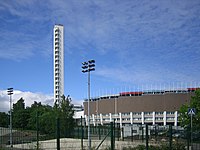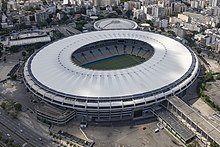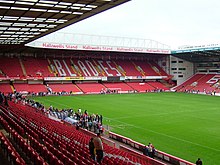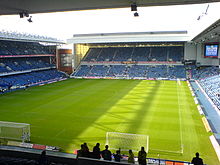Stadium






A stadium (from the Latin stadĭum, and this from the Greek στάδιον stádion) is a closed construction with stands for spectators intended for sports competitions or festivals. It depends on its architecture. It can be outdoors or covered.
It is used for various types of sports that are popular worldwide such as soccer, rugby, baseball, American football, tennis, etc. Stadiums can have a very important influence on the economy of a country by hosting all kinds of sporting events depending on the capacity they have. It consists of a large field surrounded by a structure designed so that spectators can stand or sit watching the event. Since ancient times they have always been part of people's daily lives.
In America it is called «cancha» (from Quechua: kancha 'fenced enclosure') to the playing field that is inside the stadium.
The name stadium is associated with having an athletics track.
History of stadiums
Stadion (Altgr. στάδιον) in the original sense of the word referred to an ancient Greek measure of length with a distance of 600 feet, which corresponded to a length of between 165 and 196 m, depending on the foot measurement regional. In Greece, running across a stadium field was a popular competition since the Geometric period (around 900 BC), for example at Olympia from 776 BC. C. historically transmitted. The length measurement designation has to do with the transferred competition facility, that is, to the athletics track and the spectator walls along it. Stroke length and length measurement often do not match exactly. The Athens stadium track is about 185 meters long, while the Attic stadium is about 178 meters long.
Stadiums have been found in many ancient Greek cities and sanctuaries:
- Olympia (with a track length of 192,28 m, measured between the exit and arrival thresholds), is the oldest known stadium in the world is located in Olympia, in the western Peloponnese, Greece, where the Ancient Olympic Games took place for the first time in 776 a. C. Initially it was built for a single event that was the athletic tests.
- Delfos (177,35 m),
- Athens (184.30 m),
- Epidauro (181,30 m),
- Istmia, Nemea, Messene, Mileto, Kourion (in Cyprus) and Samos.
While stadiums were still being built in Greece and Asia Minor in Roman times, they hardly played a role in Italy, as Greek sporting competitions had no cultic significance there and were long considered immoral. However, Emperor Domitian built a stadium in Rome (present-day Piazza Navona).
The amphitheatres, in which fighting games and animal hunting took place, were of much greater importance there. The best-known example is the Flavian Amphitheater in Rome, now called the Colosseum. The shape of the modern stadium developed from Roman amphitheatres. The meaning of the word stadium is much broader today and refers to sports stadiums with visitor stands, usually with an athletics track arranged around a grass playing field.
Modernity






The first stadiums built in the modern era were basic facilities, designed with the sole purpose of holding the largest possible number of spectators. With the tremendous growth in popularity of organized sport in the late Victorian era, especially association football in the United Kingdom and baseball in the United States, the first structures of this type were built. One of the first stadiums was the Bramall Lane stadium, built in 1855. International matches were played for the first time in this stadium, and in addition to football, cricket was played, a very famous sport at that time. Banned from hosting sporting events at Trinity College, Dunlop built the stadium in 1872. 'I laid a quarter-mile running path, established the current Lansdowne Tennis Club field with my own theodolite, founded a club Lansdowne archery club, a Lansdowne cricket club and last but not least the Lansdowne Rugby Football Club - red, black and yellow colours.' Some 300 loads of earth from a trench under the railway were used to raise the land, allowing Dunlop to use his engineering expertise to create a course envied throughout Ireland.
Other stadiums from this period in the United Kingdom are Stamford Bridge stadium (opened in 1877 for the London Athletic Club) and Anfield Stadium (1884 as home to Everton F.C.).
In the United States, many professional baseball teams built large stadiums primarily made of wood, the first being the South End Grounds in Boston, opened in 1871 for the team then known as the Boston Beaneaters (now the Atlanta Braves). Many of these parks burned down, and those that did not proved unsuitable for a growing game. All of the wooden parks from the 19th century were replaced, some after just a few years, and none survive today.
Goodison Park was the first association football stadium built in the world. [Construction company Kelly Brothers, based in Walton, Merseyside, was commissioned to build two open stands seating 4,000 spectators each. A third covered stand with capacity for 3,000 spectators was also requested. Everton officials were impressed with the builder's workmanship and agreed two further contracts: external fencing was built at a cost of £150 and 12 turnstiles were installed for a cost of £150. cost £7 each. The stadium was officially opened on 24 August 1892 by Lord Kinnaird and Frederick Wall of the Football Association. Soccer was not played; Instead, the 12,000 spectators watched a short athletics event followed by music and a fireworks display. Once completed, the stadium was the first jointly built football stadium in the world.
Architect Archibald Leitch brought his experience in the construction of industrial buildings to the design of functional stadiums across the country. His work spanned the first 40 years of the 20th century . One of his most notable designs was that of Old Trafford in Manchester. The stadium was originally designed to seat 100,000 spectators and featured seating in the covered south stand, while the remaining three stands were left as terraces and uncovered. It was the first stadium to feature continuous seating along the contour of the stadium. stadium.
These early venues, originally designed to host football matches, were adopted for use in the Olympic Games, the first of which was held in 1896 in Athens, Greece. The White City Stadium, built for the 1908 Summer Olympics in London, is often cited as the first modern all-seater stadium, at least in the United Kingdom. Designed by engineer J.J. Webster and completed in 10 months by George Wimpey, on the site of the Franco-British Exhibition, this 68,000-seat stadium was opened by King Edward VII on April 27, 1908. Once completed, the stadium had with a running track 24 feet (7.3 m) and three laps a mile (536 m); Outside was a 35-foot (10.7 m), 660-yard (603.5 m) cycle track. The infield included a swimming and diving pool. London Highbury Stadium, built in 1913, was the first stadium in the United Kingdom to feature a split-tier seating arrangement when it was redesigned in the Art Deco style in 1936.
The Baker Bowl, a baseball park in Philadelphia that opened in its original form in 1887 but was completely rebuilt in 1895, broke new ground in stadium construction in two important respects. The stadium's second incarnation included the world's first cantilevered second deck (stand) on a sports venue, and was the first baseball park to use steel and brick for the majority of its construction. Another influential venue was Boston's Harvard Stadium, built in 1903 by Harvard University for its Harvard Crimson football team and athletics program. It was the first stadium in the world to use concrete and steel construction. In 1909, concrete and steel construction came to baseball with the opening of Shibe Park in Philadelphia and, a few months later, Forbes Field in Pittsburgh. The latter was the first three-level sports venue in the world. The opening of these parks marked the beginning of the era of the construction of 'alajeros' type parks. The largest crowd in a stadium was 199,854 people to watch the final match of the 1950 World Cup at the Maracanã Stadium in Rio de Janeiro on July 16, 1950.
Challenges posed by its design
Different sports require playing surfaces of different sizes and shapes. Some stadiums are designed primarily for a single sport, while others can host different events, especially those with retractable seating. Stadiums built specifically for association football are common in Europe; Gaelic game stadiums, such as Croke Park, are common in Ireland, while stadiums built specifically for baseball or American football are common in the United States. The most common multi-use design combines a soccer field with a running track, although some compromises have to be made. The biggest drawback is that the stands are necessarily far from the field, especially at the ends. In the case of some smaller stadiums, there are no stands at the ends. When there are stands throughout the field, the stadium takes on an oval shape. When one end is open, the stadium is shaped like a horseshoe. All three configurations (open, oval, and horseshoe) are common, especially in the case of American college football stadiums. Rectangular stadiums are more common in Europe, especially in the case of football, where many stadiums have four stands, often distinct and very different, on all four sides of the stadium. They are often of different sizes and designs and have been erected at different periods in the stadium's history. The very different character of European football stadiums has given rise to the growing popularity of 'ground hopping', in which spectators travel to visit the stadium for its own sake and not for the event being held. in it. In recent years, the trend toward building entirely new oval stadiums in Europe has led traditionalists to criticize the designs as bland and lacking the character of the older stadiums they replace.
In North America, where baseball and American football are the two most popular outdoor sports, several multi-purpose football and baseball stadiums were built, especially during the 1960s, and some of them were successful.
Since the requirements for baseball and football are significantly different, the trend has been toward the construction of single-use stadiums, beginning with Kansas City in 1972-1973 and accelerating in the 1990s. In In several cases, an American football stadium has been built adjacent to a baseball park, to allow shared use of parking and other services. With the rise of MLS, the construction of American soccer-specific stadiums has also increased since the late 1990s to better suit the needs of that sport. In many cases, early baseball stadiums were built to fit a certain surface or block. This resulted in asymmetrical dimensions on many baseball fields. Yankee Stadium, for example, was built on a triangular block in The Bronx, New York. This resulted in a large left field dimension, but a small right field dimension.
Before more modern football stadiums were built in the United States, many baseball parks, such as Fenway Park, the Polo Grounds, Wrigley Field, Comiskey Park, Tiger Stadium, Griffith Stadium, Milwaukee County Stadium, Shibe Park, Forbes Field, Yankee Stadium, and Sportsman's Park were used by the National Football League or the American Football League. (To some extent, this continues in lower football leagues as well, as TD Ameritrade Park is used as the home stadium for the Omaha Nighthawks of the United Football League.) Along with today's single-use stadiums is the trend for retro-style ballparks closer to downtown areas. Oriole Park at Camden Yards was the first Major League Baseball ballpark of its kind to be built, using the turn-of-the-century style XX with the comforts of the XXI century.
In Taiwan there is a solar-powered stadium that produces as much energy as it needs to operate.
Stadium designers often study acoustics to increase the noise caused by fans' voices, with the aim of creating a lively atmosphere.
Lighting

Until the arrival of lamps, most matches played in large venues had to rely on natural lighting.
Bramall Lane is said to have been the first illuminated stadium. Illumination in association football dates back to 1878, when experimental illuminated matches were held at Bramall Lane, Sheffield during dark winter evenings. Since there was no national grid, the lights were powered by batteries and dynamo, and were unreliable.
Since the development of electrical grids, lighting has been an important element in stadium design, allowing matches to be played after sunset, and in covered, or partially covered, stadiums, which allow less natural light, but they provide more shelter for the public.
Modular Stadium
A modular stadium is a sports facility built from modules. Compared to a temporary stadium, modular stadiums are built without a time limit, that is, permanently. Concrete is not used in the actual structure. Steel construction prevails. Modular construction works with elements that can be expanded or reduced even after completion. In this way, the constructions remain flexibly reusable and can be easily adapted to new requirements if necessary, for example if a football club is promoted to the next higher league.
In connection with the award of the 2022 Football World Cup to Qatar, concepts for the construction of modular stadiums have already been developed and plans for modular extensions of existing sports facilities have also been presented.
List of modular stadium projects:
- Federal Festival of Free Fight and Alpine Switzerland (since 1961)
- Brita Arena Wiesbaden (2007)
- Bengasi football stadium, Libya (2007)
- Adidas World of Football Berlin (2006)
- Empire Field Stadium, Vancouver (2010)
- Tripoli Arena, Libya (2010)
- Lena Arena (Mundo de Airberlin), Fortuna Düsseldorf (2011)
Spectator and seating areas

A stadium with everyone seated has seats for all the spectators. Other stadiums are designed so that all or some spectators are standing to watch the event. The term "all-seater" It is not common in the United States, as very few American stadiums have large standing sections. Poor stadium design has contributed to disasters such as the Hillsborough disaster and the Heysel stadium disaster. Since then, all Premier League, UEFA European Championship and FIFA World Cup matches require all spectators to be seated.

Seating areas may be known as terraces, stands or decks. Originally they were intended for standing spectators, but now they are often equipped with seats. Another term used in the US is bleachers, which is mostly used for seating areas with benches rather than individual seats, and which are often uncovered; The name refers to the bleaching effect that direct, unshaded sunlight has on the benches and customers in those sections.
Many stadiums make luxury suites or boxes available to spectators at high prices. These suites can accommodate ten to thirty people, depending on the venue. Luxury suites at events like the Super Bowl can cost hundreds of thousands of dollars.
Security


Due to the number of people gathering in stadiums and the frequency of events, many notable accidents have occurred in the past, some of which have caused injuries and deaths. For example, the Hillsborough disaster was a human crush at Hillsborough Stadium in Sheffield, England, on April 15, 1989. The result of 96 deaths and 766 injuries makes it the worst disaster in the history of British sport.
Many efforts have been invested to prevent these events from being repeated, both in design and in legislation. Especially when there is a perceived risk of terrorism or violence, attention remains to prevent people from dying and maintain stadiums as places where families can enjoy a public event together.
In Europe and South America, during the 20th century, it was common for violent gangs of fans to fight in or near association football stadiums. In the UK they are known as hooligans.
Among the structural features that increase safety are separate entrance and exit accesses for each spectator area, especially the separation of accesses for home fans and visitors, dividing walls, glass parapets, vibration attenuation and sprinkler systems.
Security features include armed surveillance, ID checks, video surveillance, metal detectors and security searches to enforce rules prohibiting spectators from carrying dangerous objects or potentially dangerous.
Contenido relacionado
2008 Beijing Olympics
Calgary 1988 Olympics
San Millan de la Cogolla